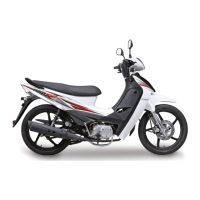
 Loading...
Loading...
Do you have a question about the KYMCO VISA R 110 and is the answer not in the manual?
| Compression Ratio | 9.2:1 |
|---|---|
| Starting System | Electric & Kick |
| Fuel System | Carburetor |
| Front Suspension | Telescopic Fork |
| Front Brake | Disc |
| Rear Brake | Drum |
| Bore x Stroke | 52.4 mm x 49.5 mm |
| Transmission | 4-Speed |
| Rear Suspension | Dual shock absorbers |
Key safety advice for riding, vehicle condition, and road awareness.
Details on essential riding gear like helmets, eye protection, gloves, and clothing.
Specifies maximum weight capacity and provides advice for safely carrying cargo or passengers.
Warns against altering the motorcycle's original design or equipment for safety reasons.
Identifies and illustrates key components and controls on the motorcycle.
Explains the functions of the ignition switch and how to lock the steering.
Describes the various indicators and gauges on the instrument panel.
Details the functions of the electric starter button on the right handlebar.
Explains the dimmer, passing light, turn signal, and horn controls on the left handlebar.
Instructions on how to open and secure the passenger seat and access the storage compartment.
Explains how to use the helmet posts for securing helmets outside the storage compartment.
Guides on checking the fuel level and safely refilling the fuel tank.
Provides essential guidelines for the initial 1,600 km to ensure proper engine and component seating.
Advises on gradually increasing lean angles for new tires to ensure maximum performance.
Offers basic checks for common starting or running issues.
Lists critical checks to perform before every ride for safety and proper function.
Step-by-step procedure for starting the engine using the electric starter.
Outlines the procedure for starting the engine using the kick starter.
Covers mounting, starting, shifting, acceleration, and safe riding techniques.
Details the procedures for safely stopping and parking the motorcycle.
Explains why regular maintenance is crucial for safety, economy, and longevity.
Outlines periodic service intervals and required maintenance tasks for optimal performance.
Covers engine oil recommendations, capacity, viscosity, and inspection procedures.
Describes how to check and adjust the clutch panel for proper operation.
Provides instructions for inspecting, cleaning, and replacing the air cleaner element.
Details how to check and adjust the throttle grip free play for smooth operation.
Explains how to inspect and adjust the drive chain slack for optimal performance.
Covers spark plug inspection, cleaning, gap adjustment, and replacement.
Guides on checking the brake fluid level and inspecting for leaks.
Details how to check brake lever free play, inspect for leaks, and check brake pad wear.
Explains how to inspect and adjust the rear brake pedal free play.
Discusses battery fluid level, cleaning terminals, and storage precautions.
Information on fuse location, specification, and replacement warnings.
Essential advice on tire condition, pressure, and safe riding practices.
Covers checking tire pressure, looking for damage, and inspecting tread depth.
Guides on checking suspension, brake levers, mirrors, license plate, reflectors, and lubrication points.
Provides instructions for washing the motorcycle to protect finishes and inspect for damage.
Advises on cleaning procedures to mitigate corrosion from road salt.
Explains how to clean and maintain painted aluminum wheels to prevent corrosion.
Details how to clean the exhaust pipe and remove heat stains.
Provides steps for preparing the motorcycle for extended storage to prevent deterioration.
Outlines the procedure for preparing the motorcycle after a period of storage.
Lists the overall length, width, height, wheelbase, and dry weight of the motorcycle.
Provides specifications for tire sizes and brake types.
Lists capacities for engine oil and fuel tank, and maximum weight capacity.
Details specifications for ignition type, battery, headlight, and other electrical components.
Outlines procedures to ensure the emission system functions properly and minimizes pollution.
Explains the closed crankcase system and how blow-by gases are managed.
Discusses compliance with noise level requirements and warns against modifying components.